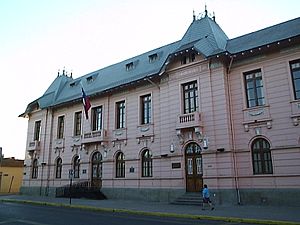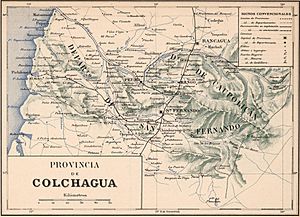Colchagua (historical province) facts for kids
Quick facts for kids
Colchagua
Provincia de Colchagua
|
|
|---|---|
|
Province of Chile
|
|

Government of Colchagua's headquarters
|
|

Colchagua Province in 1903
|
|
| Country | |
| Capital | San Fernando |
| Comunas | 15 (See list) |
| Government | |
| • Type | Provincial |
| Time zone | UTC-4 (CLT) |
| • Summer (DST) | UTC-3 (CLST) |
The historical province of Colchagua was an important area in Chile that existed from 1826 to 1976. Think of it like a state or a large county. For most of its history, its main city, or capital, was San Fernando. However, for some years, Curicó and Rancagua also served as its capital.
Contents
History of Colchagua Province
The province of Colchagua was one of the first eight provinces created in Chile. This happened through special laws on 31 January 1826. Its land included areas that were once called Colchagua, Curicó, and Talca. The 1828 Constitution, which is like a country's rulebook, officially approved the province.
Early Divisions of Colchagua
In its early years, Colchagua was split into smaller parts called "departments." These were:
- San Fernando, with its capital in San Fernando.
- Curicó, with its capital in Curicó.
- Talca, with its capital in Talca.
Changes in the 1830s
In 1833, a new Constitution changed how the country was organized. It created departments, subdelegations, and districts as smaller units within provinces. Later that year, the department of Talca was separated to form its own area, the province of Talca. In 1834, another department, department of Caupolicán, was created with Rengo as its capital.
The main city of Colchagua was often debated. San Fernando, Curicó, and Talca all wanted to be the capital. But in September 1840, a special order made San Fernando the official and permanent capital.
More Changes and New Provinces
In 1865, the department of Curicó left Colchagua. It became its own province, known as the province of Curicó. This shows how provinces could change over time.
Later, on 17 September 1925, a new law created the department of San Vicente. This new department was separated from Caupolicán.
Reorganization in the 1920s and 1930s
In 1928, the government, led by Carlos Ibáñez del Campo, decided to reorganize all the provinces in Chile. This happened through a special decree on 28 January 1929. The new Colchagua province became much larger. It now included the departments of Rancagua (capital: Rancagua) and Cachapoal (capital: Peumo). These had originally been part of the province of O'Higgins. Colchagua also gained the department of Santa Cruz (capital: Santa Cruz), which used to belong to the province of Curicó.
However, many people were not happy with these changes. So, in January 1934, the old provinces of O'Higgins and Colchagua were brought back. Colchagua kept the departments of San Fernando and Santa Cruz. In 1973, when Salvador Allende was in charge, the department of Cardenal Caro was created, with its capital in Marchigüe.
The End of Colchagua Province
In July 1974, a big reform happened under the military government of Augusto Pinochet. This reform created new "regions" in Chile. On 1 January 1976, the new VI Región (Sixth Region) was formed. This new region included the land from the old O'Higgins and Colchagua provinces. The former departments of San Fernando, Santa Cruz, and Cardenal Caro were no longer separate.
In 1979, the region was renamed "VI Región del Libertador General Bernardo O'Higgins." Today, this region includes the current provinces of Cachapoal, Colchagua, and Cardenal Caro.
See also
 In Spanish: Provincia de Colchagua (1826-1976) para niños
In Spanish: Provincia de Colchagua (1826-1976) para niños


